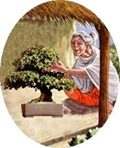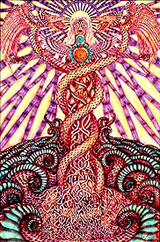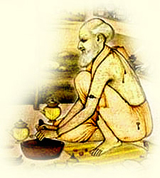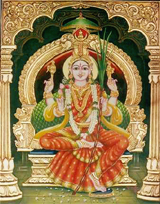A Leaf from the past
Charaka samhitaa [Ch.11, Sutrasthana]
Editor’s note
The method used by the ancients was the faculty of intuition. Even today, one finds in science, many drugs have been ‘chanced’ upon. We explain this phenomenon as follows: a scientist X is preoccupied with the idea of finding a certain cure. He first uses rational methods to their utmost. Failing this, his mental faculties are sort of silenced or stilled, even if for a while. Yet his intense search creates a condition of receptive concentration. This concentration, receptivity and stillness create the most fertile ground for intuition to develop. Later, he brushes aside the whole phenomenon as chance. The sages, aware of this, directly proceeded to ‘brain-stilling’, instead of the indirect method of preoccupation with thought (brain storming) and subsequent exhaustion of mental energies. As ‘brain-stilling’ is more difficult than ‘brain-storming’ for many, they developed other methods, so that knowledge could be gained by the fourfold examination of all existent and non-existent phenomena as authoritative statement (intuition), perception, inference and rationale. This journal uses all four methods for its enquiry and present purposes.
![]()

Now the definition of the authority (the physician) — those who are free from rajas and tamas and endowed with strength of penance and knowledge, and whose knowledge is defectless, always uncontradicted and true universally in past, present and future, are known as apta (who have acquired all the knowledge), sista (expert in the discipline) and vibuddha (enlightened); their word is free from doubt and true because, being devoid of rajas and tamas, how can they speak a lie[18-19].
![]()
The Knowledge which arises by the contact of self, organs, mind and sense objects, is explicit and only limited to the present. It is knownas perception[20].

Inference is based on prior perception. It is of three types and is related to the three times. One can infer covered fire from the smoke, sexual intercourse from observing the foetus and the future fruit from seed. By observing the bearing of similar fruit, the learned infer the causation of the seed [21-22].
![]()
The knowledge which sees things produced by combination of multiple causative factors is yukt (rationale). It is true in the three times and is also helpful in achieving the three categories (virtue, wealth and enjoyment)[25].
![]()
This is the (method and) instrument of examination and not any other, by which all to be examined; existent and non-existent, is examined.On examining by this, it is proved that rebirth is true[26].
![]()
There are three sub-pillars, three types of strength, three causes, three diseases, three passages of diseases, three types of physicians and three types of therapy[34].
![]()
The three sub-pillars are — diet, sleep and celibacy, if these three are observed properly, i.e. the body is supported well by these pillars, it lives well-endowed with strength, complexion and development till the completion of the lifespan, provided one abstains from harmful practices which will be explained here itself [35].
![]()
Strength is of three types — congenital, time-effected and acquired. Congenital is that which is natural to the body and mind; time-effected is due to seasonal variations and the age-factor. Acquired is one produced by the proper application of diet and exercise[36].

There are three causes (of disorders) — excessive, negative and perverted uses of sense-objects, actions and time. Such as – excessive gazing at over an brilliant object is excessive use, avoiding looking altogether is negative use and seeing too near, too distant, fierce, frightful, wonderful, disliked, disgusting, deformed and terrifying objects is perverted use of the visual senses. Likewise, to hear too much the loud sound of clouds, drums, cries, etc. is excessive use; not hearing at all is negative use, and hearing of harsh and frightful words and those which indicate death of dear ones, loss, humiliation, etc. is perverted use of the auditory senses. Excessive smelling of too sharp, intense and congestant odours is an excessive use, not smelling at all is negative use, and smelling of foetied, disliked, impure, decomposed, poisoned air, cadaverous odour, etc. is perverted use of the olfactory senses. Likewise, too much intake of rasas (tastes) is excessive use and not taking at all is negative use of the gustatory senses. Perverted use of those will be described in the chapter dealing with the methods of eating. Too much indulgence in very hot and very cool objects, also in bath, massage, anointing, etc. is an excessive use of tactile objects; total abstinence from them is a negative use and application of tactile objects such as hot and cold baths, etc. without the usual order and also the touch of uneven surface, injury, dirty objects, organisms, etc. is a perverted use of a tactile object[37].

Action is application of speech, mind and body. Too much application of these is excessive use and their total non-application is negative use. Holding up or forcing of urges, weeping, falling and posturing on uneven places, abnormal posturing, heating, pressing, obstruction on the breath and torturing is a perverted use of bodily actions; words indicating betrayal, lying, untimely speech, quarrels, disliking, irrelevance, indiscipline and harshness etc. come under, perverted uses of speech; fear, grief, anger, greed, confusion, conceit, envy, wrong knowledge are perverted uses of the mind[39].
![]()
There are three (types of ) diseases – innate, exogenous and psychic. Innate is that which arises due to bodily doshas; exogenous is that which is caused by bhuta (spirits and organisms) poisoned air, fire, trauma, etc.; psychic is that which is caused by non-fulfillment of desires and facing of the undesired[45].

There are three types of physicians – fraudulent, those imitating the accomplished ones and those endowed with the physician’s qualities. Those who have some containers with medicines, models (and charts), useless speech and looks, using the title of ‘physician’ are fools and fake. Those who practice in the name of physicians accomplished in wealth, fame, and knowledge, though not similar to them, are the physicians imitating the accomplished ones. Those who are accomplished in rational administration, knowledge, specific knowledge and success, want to provide happiness and promote life are the real physicians [50-53].

There are three types of therapy – spiritual, rational and psychological. The spiritual therapy consists of recitation of mantras, wearing roots and gems, auspicious acts, offerings, gifts, oblations, following religious precepts, atonement, fasting, invoking blessings, falling on (the feet of) the gods, pilgrimage, etc. The rational therapy consists of rational administration of diet and drugs. Psychological therapy is the restraint of mind from the unwholesome objects[54].

Now the summing up of verses –
Desires, sub-pillars, strength, causes, disorders, passages, physicians and therapies; these eight things have been described as threefold by Krsnatreya, wise and detached from worldly things. On these, all is based[64-65].
Share with us (Comments, contributions, opinions)
When reproducing this feature, please credit NAMAH, and give the byline. Please send us cuttings.






